AREA OF TRIANGLE WITH THREE VERTICES
Subscribe to our ▶️ YouTube channel 🔴 for the latest videos, updates, and tips.
Here, we are going to see, how to find area of a triangle when coordinates of the three vertices are given.
Let us consider the triangle given below.
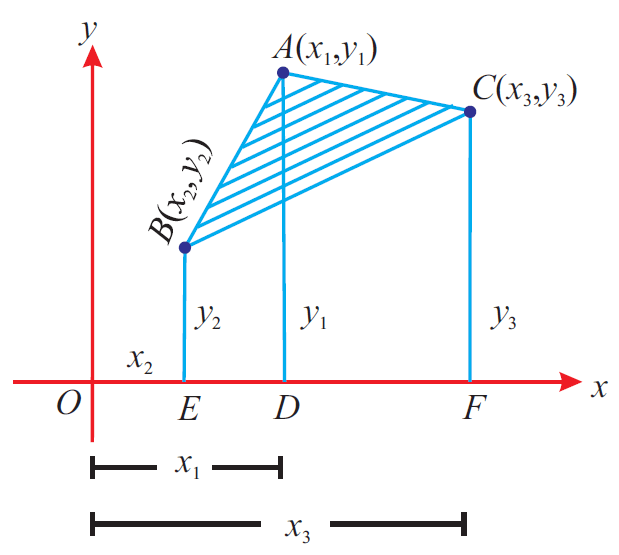
To find the area of a triangle, the following steps may be useful.
(i) Plot the points in a rough diagram.
(ii) Take the vertices in counter clock-wise direction. Otherwise the formula gives a negative value.
(iii) Use the formula given below

And the diagonal products x1y2, x2y3 and x3y1 as shown in the dark arrows.
Also add the diagonal products x2y1, x3y2 and x1y3 as shown in the dotted arrows.
Now, subtract the latter product from the former product to get area of the triangle ABC.
So, area of the triangle ABC is

Practice Problems
Problem 1 :
Find the area of the triangle whose vertices are
(1,–1), (–4, 6) and (–3, –5)
Solution :
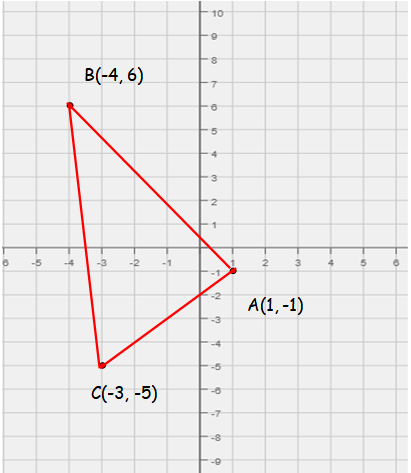
Area of triangle ABC =

= (1/2)[(6 + 20 + 3) - (4 - 18 - 5)]
= (1/2)[29 - (-19)]
= (1/2)[29 + 19]
= (1/2)48
= 24 square units
Problem 2 :
Find the area of the triangle whose vertices are
(-10, -4) (-8, -1) and (-3, -5)
Solution :
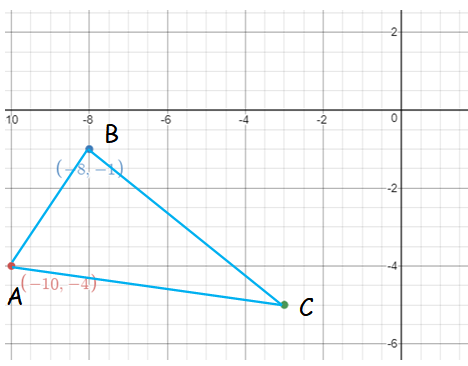
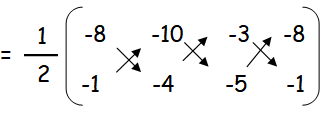
= (1/2)[(32 + 50 + 3) - (10 + 12 + 40)]
= (1/2)[85 - 62]
= 23/2
= 11.5 square units
Problem 3 :
Determine whether the sets of points are collinear.
(-1/2, 3), (-5, 6) and (-8, 8)
Solution :

= (1/2)[(-3 - 40 - 24) - (-15 - 48 - 4)]
= (1/2)[(-67) - (-67)]
= (1/2)(-67 + 67)
= 0
Because the area of the triangle is zero, the given points are collinear.
Problem 4 :
Determine whether the sets of points are collinear.
(a, b + c), (b, c + a) and (c, a + b)
Solution :

= (1/2)[a(c+a) + b(a+b) + c(b+c) - b(b+c)-c(c+a)-a(a+b)]
= (1/2)[ac+a2+ba+b2+cb+c2-b2-bc-c2-ac-a2-ab]
= 0
Problem 5 :
Find the value of p in each case.

Solution (i) :
Area of triangle = 20 square units
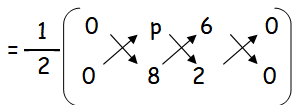
(1/2)[(0 + 2p + 0) - (0 + 48 + 0)] = 20
2p - 48 = 40
2p = 40 + 48
2p = 88
p = 44
Solution (ii) :
Area of triangle = 32 square units
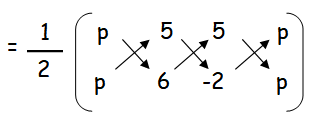
(1/2)[(6p - 10 + 5p) - (5p + 30 - 2p)] = 32
(11p - 10) - (3p + 30) = 64
11p - 3p - 10 - 30 = 64
8p = 64 + 40
8p = 104
p = 104/8
p = 13
Problem 6 :
If the area of the triangle formed by the vertices A(-1 , 2), B (k ,-2) and C(7, 4) (taken in order) is 22 sq. units, find the value of k.
Solution :
Area of triangle ABC = 22 square units

= (1/2)[(2 + 4k + 14) - (2k - 14 - 4)]
= (1/2)[(4k + 16) - (2k - 18)]
= (1/2)[4k + 16 - 2k + 18]
= (1/2)[2k + 34]
= k + 17
Equating this area to 22 square units, we get
k + 17 = 22
k = 22 - 17
k = 5
So, the value of k is 5.
Problem 7 :
If the points P(-1, -4), Q(b, c) and R(5, -1) are collinear and if 2b + c = 4, then find the values of b and c.
Solution :
Since the given point P, Q and R are collinear,

(-c - b - 20) - (-4b + 5c + 1)] = 0
[-c - b - 20 + 4b - 5c - 1] = 0
[-6c + 3b - 21] = 0
-6c + 3b = 21
Dividing by 3, we get
-2c + b = 7----(1)
c + 2b = 4 ----(2)
(1) + (2) x 2 ==> -2c + b + 2c + 4b = 7 + 8
5b = 15
b = 15/5
b = 3
Applying the value of b in (1), we get
-2c + 3 = 7
-2c = 7 - 3
-2c = 4
c = 4/(-2)
c = -2
So, the values of b and c are -2 and 3 respectively.
Problem 8 :
The floor of a hall is covered with identical tiles which are in the shapes of triangles. One such triangle has the vertices at (-3, 2), (-1, -1) and (1, 2). If the floor of the hall is completely covered by 110 tiles, find the area of the floor.
Solution :
Let the vertices be A(-3, 2), B(-1, -1) and C(1, 2)
Area of one triangular tile =

= (1/2)[(3 - 2 + 2) - (-2 - 1 - 6)]
= (1/2)[(3 - (-9)]
= (1/2)[3 + 9]
= (1/2)(12)
= 6 square units.
Area of 110 tiles = 6(110)
= 660 square units.
Problem 9 :
The given diagram shows a plan for constructing a new parking lot at a campus. It is estimated that such construction would cost $1300 per square feet. What will be the total cost for making the parking lot?
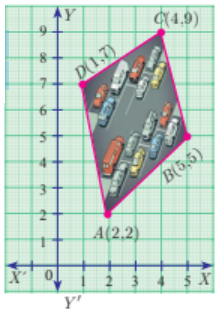
Solution :
Area of quadrilateral =

= (1/2) [(10 + 45 + 28 + 2) - (10 + 20 + 9 + 14)]
= (1/2) [85 - 53]
= (1/2) (32)
= 16 square units
Cost per square feet = $1300
Total cost = 16(1300)
= $20800
Subscribe to our ▶️ YouTube channel 🔴 for the latest videos, updates, and tips.
Kindly mail your feedback to v4formath@gmail.com
We always appreciate your feedback.
About Us | Contact Us | Privacy Policy
©All rights reserved. onlinemath4all.com
Recent Articles
-
Quantitative Reasoning Questions and Answers
Dec 14, 25 06:42 AM
Quantitative Reasoning Questions and Answers -
Specifying Units of Measure
Dec 14, 25 06:38 AM
Specifying Units of Measure -
Coin Tossing Probability
Dec 13, 25 10:11 AM
Coin Tossing Probability - Concept - Sample Space - Formula - Solved Problems